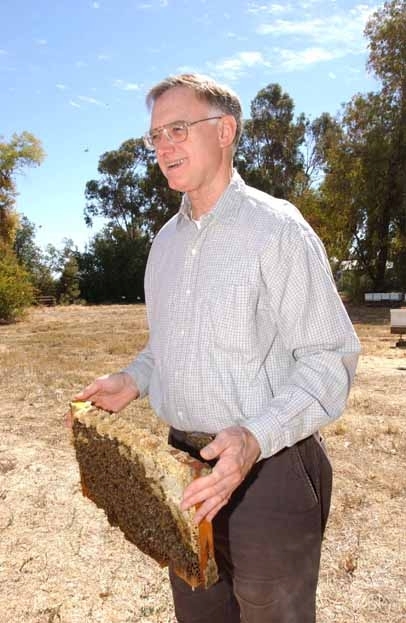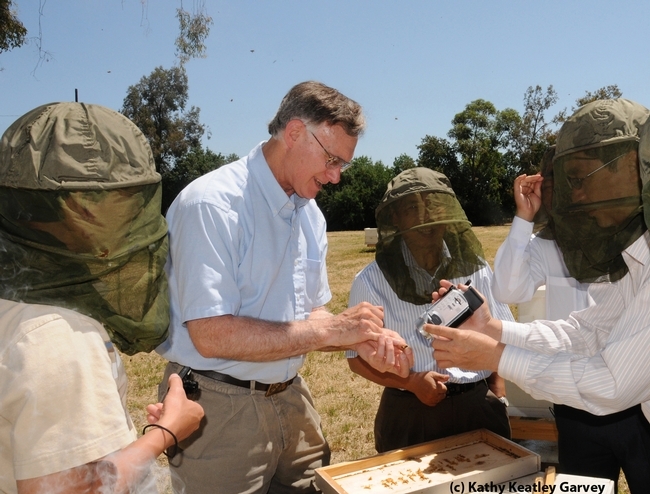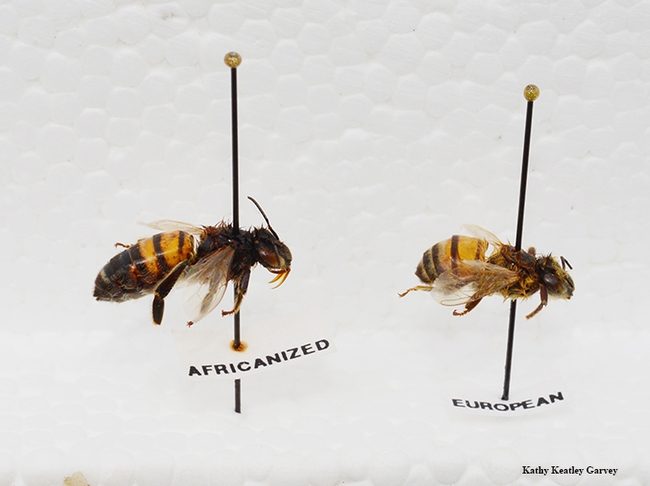
Although Extension apicuturist emeritus Eric Mussen of the UC Davis Department of Entomology and Nematology, retired in 2014 after 38 years of service, he continues his Extension work.
When a backyard beekeeper's hive in Concord turned aggressive (a swarm killed two dogs, attacked a mail carrier, and stung passsersby), journalists began singling out honey bee guru Eric Mussen and other UC Davis experts for interviews. Apparently, when a beekeeper moved his hive on Friday to make way for landscaping, the bees went on the defensive Friday and Saturday. Most of the bees have since been destroyed.
Some headlines screamed "Killer bees colonizing the Bay Area."
First of all, are they Africanized bees? DNA testing awaits.
“Their BEHAVIOR is very SUGGESTIVE that they could be Africanized,” Mussen told Bug Squad today.
“Until someone runs a definitive test on the on the bees actually involved in the Concord stinging incident, we may never know exactly what genotype the bees were,” Mussen points out, adding that "we have three ways to try to differentiate between Africanized honey bees (AHBs) and European honey bees (EHBs)."
1. Mitochondrial DNA – The California Department of Food and Agricuture (CDFA) still conducts this type of testing once a year to clear the California Bee Breeders for queen exports into Canada. CDFA also uses this criterion as "the one" for declaring Africanization. However, its value in predicting temperament of the colony population is not particularly reliable.
2. Isozymes - the amino acid composition of certain enzymes differs between the two races
3. Morphometrics - computer matching of current sample specimens to verified AHB and EHB samples using measurements of various anatomical features. Hybrids are problematic.
"That type of bee was found around southern California and as far north as not too far from Angles Camp (Calaveras County)," Mussen mentioned. "Further north, they found only specimens with one or two traits, but not all three. That even occurred just into southern Oregon."
“Yes, EHB colonies can behave in that nasty manner, but I think it is more likely that AHBs are involved,” Mussen says. He recalled that twice in the 1980s, swarms of bees from South America accompanied shipments of raw sugar cane into the C&H sugar refinery in Crockett (Contra Costa County).
“We know the first one got away. They think they got the second one, but could not find the queen in either case. Since that time, there have been increasing complaints of "hot" bees from that area, south to Castro Valley (Alameda County).”
Mussen related that “you don't have to have bees that test positive for AHB mitochondria to get extremely defensive behavior. Studies conducted by Dr. Robert Page's lab workers in Mexico (see photo of an Africanized bee below that Page collected) demonstrated the gradual changes in behavior that accompanied increased proportions of AHB semen in A.I. EHB queens":
- 12.5 percent - increased runniness on combs
- 25 percent - add flighty to the list
- 37.5 percent - add significantly more stings to the list
- 50 percent or more - results in full-blown AHB defensive behavior.
“So, if feral AHB colonies exist in the environment, we can have various amounts of ‘mismating' going on and its consequences around the area," Mussen points out,
“Another consideration is that mini-swarms of AHBs sometimes will alight on the outside of an EHB hive and park there for days. The AHB workers slowly integrate themselves into the colony population. Then, when conditions are right, the AHBs kill the EHB queen, the AHB workers and queen march in and take over (usurp the colony).”
“A third possibility is that some novice beekeeper was swayed by advertising for packaged bees from Texas. Advertised as the most gentle stocks, there is no place where mating can be isolated enough to avoid AHB drones.”
Africanized bees are hybrids of a subspecies of bee from southern Africa that was exported to Brazil to improve breeding stock and honey production. Scientists say it escaped and spread throughout South America and into Central America. It expanded into Mexico in 1985, in Texas in 1990, in Arizona in 1993, and in southern California in 1994.
Attached Images:

Honey bee guru Eric Mussen, now Extension apiculturist emeritus, opening a hive at UC Davis for a group tour. These are European honey bees, also called Western honey bees. (Photo by Kathy Keatley Garvey)

An Africanized bee collected in Mexico by Rob Page, former professor and chair of the UC Davis Department of Entomology, is positioned next to a European honey bee. The EHB may have shrunk; the bees are considered non-distinguishable except through DNA tests. (Photo by Kathy Keatley Garvey)